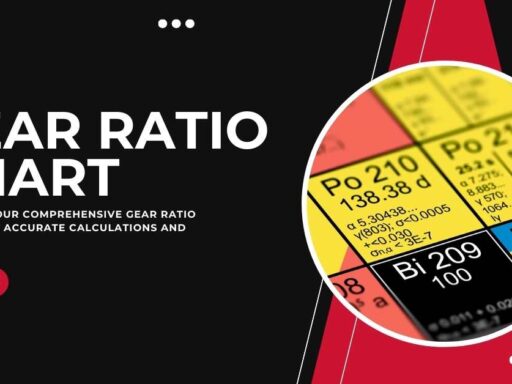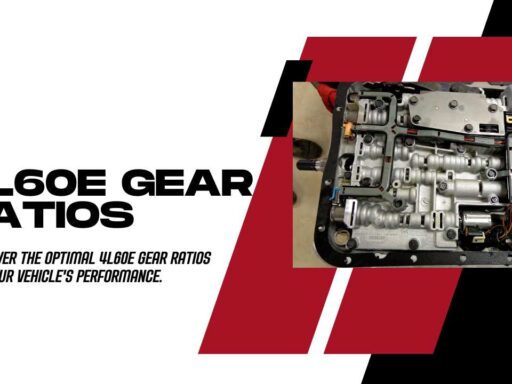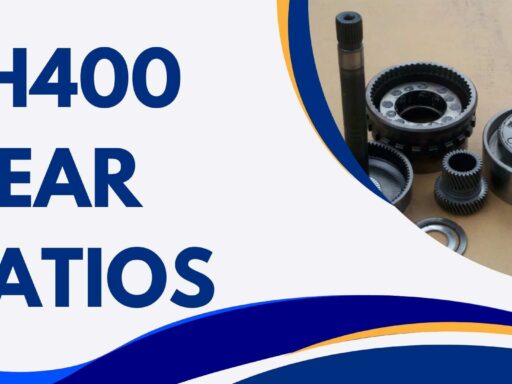Master the art of How to figure gear ratio calculation and revolutionize your engineering skills. Explore our website for expert advice and practical tips on optimizing gear systems for maximum efficiency.
Ever found yourself stumped and slightly overwhelmed trying to figure out the gear ratio? Well, you’re not alone. It might seem like a daunting task, packed with unpalatable jargon and complex equations, but we’re here to break it down for you. With our guidance and your attention, you’ll soon master this technical yet intriguing topic.
“Mastering gear ratios can seem complex, but once broken down, it translates to simpler mechanics.”
By the end of this article, we promise you’ll have a solid understanding of how gear ratios work, why they’re important, and, most importantly, how to figure them out. Whether you’re a curious learner, an automotive enthusiast, or a professional in the field, let’s embark on this enlightening journey together. So, put on your thinking cap, and let’s get those gears turning! If you have more information on Gear Guide related this is a very good detail.
Understanding the Basics of How to figure gear ratio
If you’ve ever ridden a bicycle, changed gears in a car, or engaged the chain drive in a power tool, you have experienced the application of gear ratios firsthand. In essence, a gear ratio is a direct representation of the mechanical advantage one gear has over another in a system. It’s a relationship, a comparison, if you will, between the number of teeth in one gear to the number of teeth in another gear.
The gear ratio, often represented by the symbol GR, can be calculated using a simple formula: Gear Ratio (GR) = Number of Teeth on Driven Gear (T2) / Number of Teeth on Driving Gear (T1). Here, the Driving Gear or T1 is the power source, such as the engine or motor, that moves the first gear of the system. The Driven Gear, or T2, on the other hand, is the gear that receives power from the Driving Gear and shifts the gear train into motion.
You may wonder why gear ratios matter. To put it simply, they greatly influence the power output and fuel efficiency of vehicles, the performance of machinery, and even the functioning of everyday equipment ranging from wristwatches to electric toothbrushes. A higher gear ratio provides more torque, useful for climbing hills or towing heavy loads, but often at the expense of speed. Conversely, a lower gear ratio allows for higher speeds but with reduced torque.
Deducing the right gear ratio depends on the specific task at hand and the performance you desire from your gear system. It’s quite similar to preparing a recipe – too much or too little of an ingredient can change the end result drastically. So, whether you’re an aspiring mechanic, an engineer, or simply a curious mind, understanding gear ratios can equip you with the knowledge to make informed decisions on gear system designs and optimizations.
In the world of engineering, varying gear ratios are widely used in diverse applications. For instance, in an automobile, the transmission uses different gear ratios to provide the right amount of power and speed at different driving conditions. Similarly, in clock mechanisms, different gear ratios are employed to ensure that the hour, minute, and second hands move at the correct rates.
Realistically, mastering the art of gear ratios is a process of continual learning and experimentation. However, being able to decipher this mathematical relationship is a step towards becoming cognizant of the complex mechanical world we interact with every day.

Credit: www.pexels.com
The Importance of Gear Ratios in Performance Tuning
Let’s dive deeper into why gear ratios matter so much in terms of performance tuning. You see, the gear ratio plays a significant role in controlling both speed and torque in mechanical systems. It’s like deciding how hard and how long a runner should stride – Do they take quick, swift steps for a short sprint or long, steady strides for a marathon?
Take drag racing, for instance, a sport built on remarkable speed over a short distance. These machines are geared to take full advantage of their engine’s powerband. This is where a lower gear ratio comes in handy, allowing for accelerated speed but reducing the gear’s power. On the other hand, for road racing, a higher gear ratio is preferable. It helps maintain power over a long span, aiding in increased longevity and lasting power, though it may compromise on an initial speed boost.
Gearing calculation and gear ratios, hence, hold a pivotal place in designing efficient mechanical systems. The ‘optimal gear ratio’ is often a balancing act between speed and torque based on specific performance requirements. It can significantly contribute to maximizing the efficiency of mechanical systems, leading to smoother operations and longevity of engine life.
Hopefully, we have managed to underscore the critical role gear ratios play in performance tuning by now. The crux of the matter? The right gear ratio can perfect your ride, whether on the race track or on the road.
Step By Step Guide: How to Calculate Gear Ratios
So, you are ready to dive into the interesting process of figuring out gear ratios? Awesome! Let’s break this down into manageable steps. It’s not as daunting as it seems, I promise!
The first step in calculating gear ratio is to identify both your driving and driven gears. Remember, the driving gear is the one that is the initial source of power, typically powered by the engine. The driven gear is the one that has its teeth engaged by the driving gear. Now, we need to count the number of teeth on each gear.
In the simplest formula for calculating gear ratios, divide the number of teeth on the driving gear (T2) by the number of teeth on the driving gear (T1). This gives you a basic gear ratio (GR) for a direct drive mechanism.
Gear Ratio (GR) = Number of Teeth on Driven Gear (T2) / Number of Teeth on Driving Gear (T1)
Though simple, the basic formula does not account for all scenarios and may alter in more complex systems such as those found in automobiles. There, the final drive ratio and the transmission gear ratio come into play, along with the diameter of the tire. The formula becomes:
Gear Ratio (GR) = (RPM x Tire Diameter Inches) / (Final Drive Ratio x Transmission Gear Ratio x 336)
Why the number 336, you might ask? Well, it’s to convert the tire diameter from inches to miles and minutes to hours. It’s more complex but vital when dealing with vehicular systems.
While it might seem like a daunting calculation, keep in mind that, in essence, a gear ratio tells us how many times the driving gear must turn to make the driven gear turn once. Simplifying the process into smaller steps can really help with understanding!
Remember to carefully evaluate your gear ratio result. High gear ratios result in increased force but decreased speed, thus are ideal for power. On the contrary, low gear ratios result in higher speeds but at the expense of torque, making them excellent for speed.
With practice, the calculation and application of gear ratios can become second nature. It’s a powerful tool in your kit, whether you’re a budding engineer, a seasoned mechanic, or a performance-tuning aficionado!
Diving Deep into Gear Ratio Formulas
| Item | Description | Formula |
| Gear Ratio (GR) | This represents the ratio between the ‘driven’ gear and the ‘driving’ gear. A higher gear ratio indicates a powerful gear, while a lower ratio means increased speed. | GR = T2 / T1 |
| Number of Teeth on Driven Gear (T2) | The ‘driven’ gear is the gear that is powered by the ‘driving’ gear. The number of teeth will determine how much power is transferred. | |
| Number of Teeth on Driving Gear (T1) | The ‘driving’ gear is the one that is directly powered, usually by the engine or motor. The number of teeth will affect the speed of the ‘driven’ gear. |
The Impact of Gear Ratios on Speed and Torque
- Smaller gears turn faster than larger gears; this impacts the gear ratio and, consequently the speed and torque of the machine.
- The gear ratio affects the torque that can be applied to the final drive – a high gear ratio will amplify torque, making tasks involved with heavy loads and precision easier.
- Conversely, low gears or a low gear ratio can reduce torque but increase speed, making these gears ideal for tasks that require rapid movement and efficient power transmission.
- The science of gear ratios is a critical parameter in not just automotive engineering but also in other areas like the design and operation of wind turbines and production machinery.
- Correct gear ratio can be the difference between an efficient machine and one that excessively consumes power. Hence, understanding and applying the right gear ratio is important for power optimization and energy efficiency in various mechanical devices.
- Changing a vehicle’s gear ratio can significantly alter its performance, such as increasing top-end speed or enhancing low-end torque.
- High gear ratios are beneficial for situations requiring steady power, such as towing, uphill climbing, or carrying heavy loads. On the other hand, low-gear ratios are preferred for situations where more speed is required, such as in racing.
- Be it a common bicycle or a high-speed race car, gear ratios play a significant part in their functioning, influencing both speed and torque.
The Influence of Gear Ratios on Fuel Efficiency
When you hit the road, have you ever pondered over why modern cars have such a myriad of gears? This is where the concept of gear ratios becomes effective for fuel efficiency.
Fuel efficiency, a major concern for any vehicle owner, is directly influenced by the gear ratios in your vehicle’s transmission. Remember, a lower gear ratio can deliver greater power and acceleration but higher fuel consumption. In contrast, a higher gear ratio provides lower power but better fuel economy.
Consider this as an example. Assume that a car is traveling at a constant speed on a flat road. The greater number of revolutions the engine has to make to keep the car moving, the more fuel it requires. Therefore, in such a scenario, a higher gear ratio – meaning the engine spins slower for each revolution of the wheels, could result in significant fuel savings.
Modern vehicles have more gears in their transmission system to ensure that the engine runs at an optimum speed. Their goal is to keep the balance between power and fuel efficiency. And this optimization is critically done through the right selection of gear ratios.
This is especially crucial in terms of energy conservation, where vehicle designers and engineers carefully calculate and choose the gear ratios, following the vehicle’s design specifications and expected driving conditions, to make sure your vehicle enjoys maximum fuel efficiency without compromising its performance.
So, the next time you cruise along a highway, just remember that the smooth ride and low number on your fuel gauge owe quite a bit to these carefully chosen gear ratios. In a nutshell, understanding gear ratios not only enables you to grasp the fantastic engineering that goes into each gear change, but it also helps you to optimize fuel efficiency, further contributing to a more sustainable future.
Practical Applications of Gear Ratios
Deciphering gear ratio calculations can seem like a daunting task. But believe it or not, you encounter gear ratios in everyday life more often than you’d think! The practical application of gear ratios is extensive, influencing numerous elements across multiple industries.
Consider cycling, for instance. The bicycle’s gearing system is based on gear ratios. Think about the times you’ve had to pedal uphill – you most likely shifted to a lower gear. In this scenario, a smaller gear (driving gear) is turning a larger one (driven gear), resulting in a gear ratio of less than 1. This low-gear ratio provides the high torque needed to conquer that steep hill while maintaining control and stability.
Now, picture the opposite scenario: cruising downhill or sprinting on a flat terrain. You then switch to a higher gear, where the driving gear (larger) turns the driven gear (smaller). This represents a gear ratio greater than 1, allowing you to achieve higher speeds with less pedaling.
On a larger scale, gear ratios play a critical role in the field of automotive engineering. The transmission system of your car uses different gear ratios to match the engine’s performance to your driving demands. Whether you’re accelerating from a stop, overtaking on the highway, or climbing a steep hill, the right gear ratio supports performance, engine efficiency, and fuel economy.
Apart from these examples, gear ratios are also critical in clocks, industrial machinery, music boxes, and an array of mechanical devices. They essentially control the speed and torque, optimizing the performance depending on the scenario.
To sum up, grasping the concept of gear ratios is fundamental to understanding the working principles of mechanical systems. Next time you shift gears on your bike or in your car, remember the mathematics and the mechanics behind the seamless operation. It’s the art of gear ratios at work!
Understanding the Role of Gear Ratios in Bicycle Performance
In the world of cycling, gear ratios are essential in determining how effectively your bike moves. They’re the critical link between the energy you generate by pedaling and the propelling force that pushes your bike forward. So, what exactly does this all mean for your biking performance?
A bicycle uses a system of front and rear gears, often called sprockets or cogs. When connected by the chain, these gears offer a spectrum of gear ratios, affecting the bike’s speed and the amount of force needed for pedaling.
When you switch to a gear combination that provides a higher gear ratio, you’ll find that you’re able to go swiftly but only with a significant amount of pedal force. This might be suitable when you’re attempting to bike at high speeds on flat terrain. Alternatively, a lower gear ratio eases the pedal stress but decreases speed, something you might want when you’re climbing a steep hill.
For a casual rider, the standard gear ratios in most bikes suffice. However, serious bikers often tweak their ratios for particular kinds of riding. Say you primarily undertake downhill mountain biking; a set of lower gear ratios would likely be most effective. Alternatively, if speed is what matters most on a racing circuit, higher gear ratios would be the way to go.
Understanding gear ratios and how to adjust them could truly squeeze out that last piece of power and efficiency from your bike.
In the world of engineering, the concept of gear ratios extends beyond bicycles. Gear ratios are used in cars, motorcycles, and a wide range of other machinery, affecting the rate of power transmission and overall equipment efficiency. But the principles remain the same: It’s all about the effective translation of input power into the desired output.
Troubleshooting Performance Issues with Gear Ratios
All right, so you now know the basics of gear ratios, why they matter in performance tuning, how to calculate them, and even what they mean for speed, torque, and fuel efficiency. But what if there’s a hiccup in the operation? What if your gear system isn’t delivering the performance you expect?
Don’t fret. These things happen, and often, they’re down to issues with the gear ratios. Let’s look at how you can troubleshoot performance problems, specifically related to gear ratios.
The first step in troubleshooting gear ratio performance issues is to confirm if the issue is true with the gear ratio. To do this, you need to take into account several variables. For instance, have there been any recent changes to the gear system, such as new gears or a different transmission?
Also, consider the type of driving you’ve been doing. Have you been consistently driving at high speeds or putting a lot of strain on the gears? This can cause wear and tear, leading to decreased performance.
Another factor to consider is the overall condition of your vehicle. Is it well-maintained with regular servicing and tune-ups? A poorly maintained vehicle can also affect gear ratio performance.
Conclusion of How to figure gear ratio
Before jumping to conclusions about How to figure gear ratio being the issue, it’s important to thoroughly assess and evaluate all possible factors that could be contributing to the problem. By identifying and addressing these issues, you can improve your gear ratio performance and ensure a smoother driving experience.






